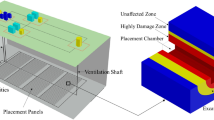Summary
Time-Dependent Behaviour of Fractured Rock
Knowledge of the time-dependent behaviour of fractured rock is particularly important in designing rock structures for longterm stability. This paper is an attempt to determine the time-dependent behaviour of fractured rock as it might prevail under in-situ conditions. The following cases are considered:
-
(i)
Gradually increasing compression at different but constant rates of deformation;
-
(ii)
Gradually increasing compression at changing rates of deformation;
-
(iii)
Constant load application for various time durations.
It is shown that fractured rock does have a long-term strength and while its resistance and deformation are initially affected by time, stability is reached at a certain stage. It is thus possible to determine long-term stability curves for fractured rock. This may yield design data for stable rock structures subjected to low rates of loading.
Zusammenfassung
Das zeitabhängige Verhalten von gebrochenem Gestein
Für den Entwurf von Felskonstruktionen, die über lange Zeiträume stabil sein sollen, ist es besonders wichtig, das zeitabhängige Verhalten von gebrochenem Gestein zu kennen. In der vorliegenden Arbeit wird versucht, das zeitabhängige Verhalten von gebrochenem Gestein zu ermitteln, wie es unter untertägigen Bedingungen in Erscheinung treten könnte.
Folgende Fälle werden behandelt:
-
(i)
Allmählich steigende Druckbelastung bei verschiedenen, jedoch konstanten Verformungsgeschwindigkeiten;
-
(ii)
Allmählich steigende Druckbelastung bei veränderlichen Verformungsgeschwindigkeiten;
-
(iii)
Konstante Lastaufbringung während verschieden langer Zeiträume.
Es wird nachgewiesen, daß gebrochenes Gestein eine Langzeitfestigkeit besitzt und daß Stabilität zu einem gewissen Zeitpunkt erreicht wird, obwohl Widerstand und Verformung anfänglich durch die Zeit beeinflußt werden. Es ist daher möglich, Langzeitstabilitätskurven für gebrochenes Gestein zu bestimmen. Dies kann zur Erarbeitung von Entwurfsdaten für stabile Felskonstruktionen führen, die geringen Belastungsgeschwindigkeiten ausgesetzt sind.
Résumé
Le comportement de la roche fracturée en fonction du temps
La connaissance du comportement de la roche fracturée en fonction du temps est particulièrement utile au calcul de la stabilité prolongée des structures rocheuses. Aussi a-t-on cherché à déterminer le comportement probable, en fonction du temps, d'une roche fracturée en régime naturel. On a envisagé les éventualités suivantes:
-
(i)
une compression croissante avec différentes vitesses de déformation constantes;
-
(ii)
une compression croissante avec des vitesses de déformation variables;
-
(iii)
une charge de grandeur constante de durée variable.
On a démontré que la roche fracturée possède en effet une stabilité de longue durée. Bien qu'au début sa résistance et sa déformation soient affectées par le temps — sa stabilité est atteinte à une certaine époque. Il est ainsi possible de déterminer des courbes de stabilité de longue durée des roches fracturées. Ceci pourrait fournir des données pour le calcul de stabilité de structures rocheuses soumises à des taux de chargement modérés.
Similar content being viewed by others
References
Bieniawski, Z. T.: Mechanism of rock fracture in compression. Rep. Counc. scient. ind. Res. S. Afr., MEG 459, 1966.
Bieniawski, Z. T.: Mechanism of brittle fracture of rock. Int. J. Rock Mech. Min. Sci.4 407–430, 1967.
Bieniawski, Z. T., H. G. Denkhaus, and U. W. Vogler: Failure of fractured rock. Int. J. Rock Mech. Min. Sci.6 323–341, 1969.
Bieniawski, Z. T.: Deformational behaviour of fractured rock under multiaxial compression. Proc. Int. Conf. Structure, Solid Mechanics and Engineering Design, John Wiley & Son, London, 55/1–55/10, 1969.
Bieniawski, Z. T.: Load-deformation behaviour of coal after failure. Proc. 2nd Congress Int. Soc. Rock Mech., Belgrade,1 467–473, 1970.
Cook, N. G. W.: Failure of rock. Int. J. Rock Mech. Min. Sci.2 289–403, 1965.
Cook, N. G. W., and J. P. M. Hojem: A rigid 50-ton compression and tension testing machine. S. Afr. Mech. Engr.16 89–92, 1966.
Fairhurst, C., and N. G. W. Cook: The phenomenon of rock splitting parallel to a surface under compressive stress. Chamber of Mines of South Africa Research Report No. 65/65, 1965. Also in: Proc. 1st Congress Int. Soc. Rock Mech., Lisbon,1 687–691, 1966.
Jaeger, J. C., and N. G. W. Cook: Fundamentals of rock mechanics, Methuen & Co., London 1969.
Rüsch, H.: Researches towards a general flexural theory for structural concrete. American Concrete Institute Proceedings57 1–28, 1960.
Rüsch, H.: Verformungseigenschaften von Beton unter zentrischen Zugspannungen. Voruntersuchungen, München, Bericht Nr. 44, 1963.
Serdengecti, S., and G. D. Boozer: The effects of strain rate and temperature on the behaviour of rock subjected to triaxial compression. Proc. Fourth Symposium on Rock Mechanics, Society of Mining Engineers, New York, 83–97, 1961.
Wawersik, W.: Detailed studies of rock fracture in compression. Thesis, University of Minnesota, Minneapolis 1968.
Author information
Authors and Affiliations
Additional information
With 10 Figures
Rights and permissions
About this article
Cite this article
Bieniawski, Z.T. Time-dependent behaviour of fractured rock. Rock Mechanics 2, 123–137 (1970). https://doi.org/10.1007/BF01239744
Received:
Issue Date:
DOI: https://doi.org/10.1007/BF01239744




